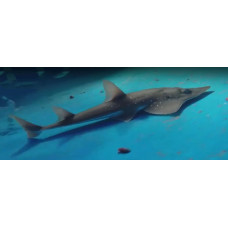Latin name
Rhynchobatus djiddensis
Other name
Whitespotted wedgefish
Identification
This species can be confused with its distant relative, the common shovelnose ray, from which it differs in having a smaller first dorsal fin located further back on the body; a more rounded head with a protruding snout; the absence of indentations on the upper jaw; and larger skin denticles and a pronounced pointed snout.
Features of fish fins
The tail, dorsal, and pectoral fins resemble those of a shark. These stingrays do not use their pectoral fins to swim like most stingrays, but they do use their tails to swim like sharks.
Fish colouring
Giant guitarfish are brownish or grayish on top with a variable pattern of white spots. Juveniles have a black spot over each pectoral fin, but this is a dark ring or absent in adults. There is a dark band pattern between the eyes (on the top of the head) that distinguishes them from other Rhynchobatus species in the area. In addition, guitarfish can also be characterized by large black eye patches at the base of the pectoral fin.
Distribution
Widespread in the western Indian Ocean: restricted to the Red Sea and tropical western Indian Ocean to South Africa. Also reported from the Persian Gulf.
Habitat
A marine tropical species that inhabits 2-50 m (6.6-164.0 ft) depths, in areas with sandy seafloors.
Size
A large fish that can reach 3.1 m (10 ft) in length and weigh up to 227 kg (500 lb).
Behavior
They are a shy fish. They usually swim around coastal reefs or reef flats, but sometimes venture into the brackish waters of estuaries.
Food and feeding habits
This species feeds on clams, crabs, lobsters, squid and small fish. Despite the lack of cutting teeth, they are known predators among stingrays. Reproduction
Reproduction
The giant guitarfish is considered an oviparous fish. The embryos are initially fed on egg yolk and then receive additional nutrients from the mucus-enriched uterine fluid obtained by indirect absorption. Due to their low fecundity, they are known to produce an average of four young per summer.
Fishing
Giant guitarfish have been used as bycatch, resulting in severe depletion, population decline and extinction. These fish are also harvested by commercial, artisanal and subsistence fisheries using a variety of fishing methods, including gillnets, trawls, traditional hook and line, traps and seines. Caught fish are retain for the value of their fins.
Relationship with a person
A species not harmful to humans. Meat and fins are sought after in Asian markets.
| Classification | |
| Phylum | Chordata |
| Class | Chondrichthyes |
| Squad | Rhinopristiformes |
| Family | Rhinidae |
| Genus | Rhynchobatus |
| Species | R. djiddensis |
| Features | |
| Conservation status | Critically Endangered |
| Habitat | Pelagic |
| Life span, years | No information |
| Maximum body weight, kg | 227 |
| Maximum length, cm | 310 |
| Sailing speed, m/s | No information |
| Threat to people | Edible |
| Way of eating | Predator |
Giant guitarfish
Tags: giant guitarfish



